中国传统文化-英文版
- 格式:pptx
- 大小:3.24 MB
- 文档页数:22
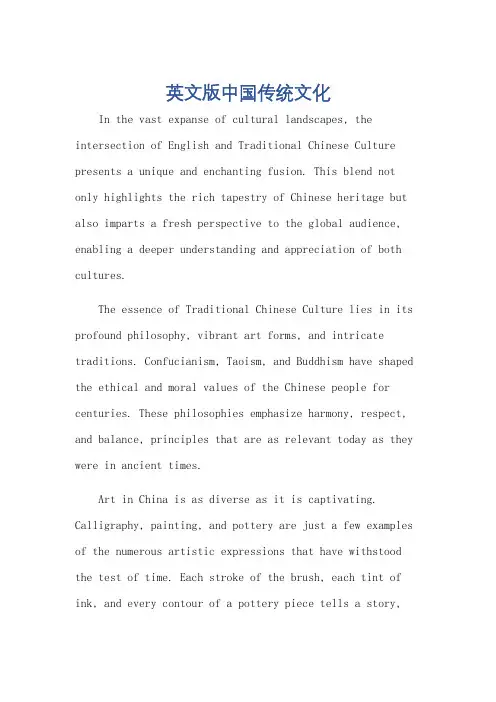
英文版中国传统文化In the vast expanse of cultural landscapes, the intersection of English and Traditional Chinese Culture presents a unique and enchanting fusion. This blend not only highlights the rich tapestry of Chinese heritage but also imparts a fresh perspective to the global audience, enabling a deeper understanding and appreciation of both cultures.The essence of Traditional Chinese Culture lies in its profound philosophy, vibrant art forms, and intricate traditions. Confucianism, Taoism, and Buddhism have shaped the ethical and moral values of the Chinese people for centuries. These philosophies emphasize harmony, respect, and balance, principles that are as relevant today as they were in ancient times.Art in China is as diverse as it is captivating. Calligraphy, painting, and pottery are just a few examples of the numerous artistic expressions that have withstood the test of time. Each stroke of the brush, each tint of ink, and every contour of a pottery piece tells a story,reflecting the artist's thoughts, emotions, and thecultural ethos of their era.Festivals and traditions are another vibrant aspect of Chinese culture. The Lunar New Year, Mid-Autumn Festival, and the Dragon Dance are celebrations that bring joy and unity to families and communities. These traditions are not just rituals but also a way of life, passed down through generations, connecting people to their ancestors and to the land.When Traditional Chinese Culture meets English, it opens up a world of possibilities. English, as a global language, provides a platform for the world to discover the richness of Chinese heritage. Through translations and interpretations, the depth and complexity of Chineseculture are made accessible to a wider audience.In this fusion, we see how English words and phrases are creatively adapted to capture the essence of Chinese traditions. For instance, the term "Confucius sayings" or "Taoist philosophy" are used to introduce Westerners to the wisdom of ancient Chinese thinkers. These translations notonly convey the meaning but also retain the cultural authenticity of the original.Moreover, English has also borrowed many elements from Chinese culture, enriching its vocabulary and expression. Words like "tea," "silk," and "paper" have become synonymous with Chinese culture, reflecting the influenceof China on global history and trade.In conclusion, the enchanting fusion of English and Traditional Chinese Culture is a testament to the power of cultural exchange and understanding. It bridges the gaps between East and West, allowing for a deeper appreciationof both cultures. As we continue to explore and embracethis fusion, we are reminded of the beauty and diversitythat can arise when different cultures come together in harmony.**东西方文化的魅力融合——英文版中国传统文化** 在丰富多彩的文化景观中,英语与中国传统文化的交融展现出独特而迷人的魅力。
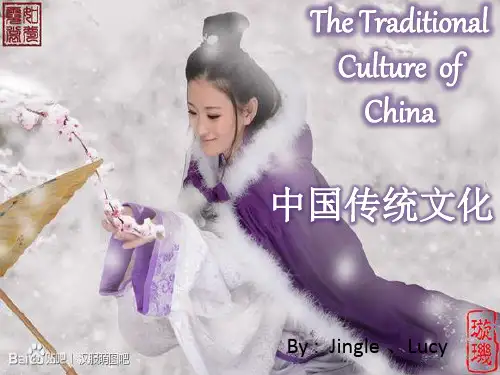
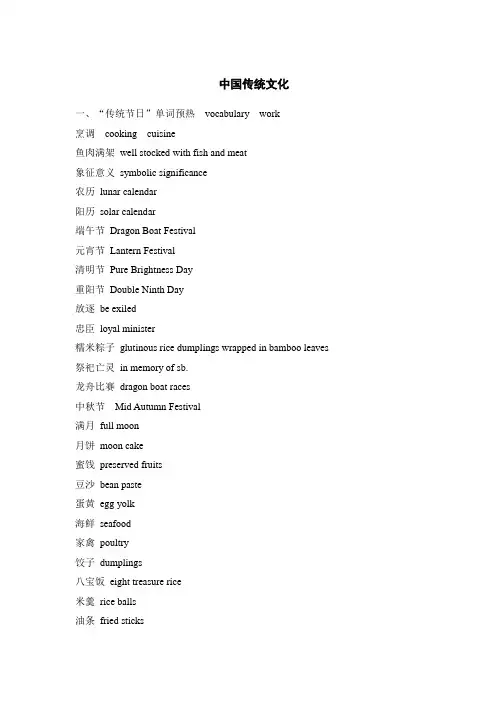
中国传统文化一、“传统节日”单词预热vocabulary work烹调cooking cuisine鱼肉满架well stocked with fish and meat象征意义symbolic significance农历lunar calendar阳历solar calendar端午节Dragon Boat Festival元宵节Lantern Festival清明节Pure Brightness Day重阳节Double Ninth Day放逐be exiled忠臣loyal minister糯米粽子glutinous rice dumplings wrapped in bamboo leaves 祭祀亡灵in memory of sb.龙舟比赛dragon boat races中秋节Mid Autumn Festival满月full moon月饼moon cake蜜饯preserved fruits豆沙bean paste蛋黄egg yolk海鲜seafood家禽poultry饺子dumplings八宝饭eight treasure rice米羹rice balls油条fried sticks麻花fried twisted stick炒面Chaomian叉烧包steamed bun with roast pork粥porridge芋头taro葱油饼pan-fried cake with sesame seeds and green onion有关春节的常用词放鞭炮let off firecrackers耍龙灯play the dragon lantern耍狮子play the lion dance拜年pay a new-year callChinese to English:1. 玉器是光辉灿烂的中华民族历史文化宝库中一枝异彩独放的奇葩。
中国玉器在新石器时代的河姆渡文化时期就开始出现。
7000年来一直延续不断,发展至今。
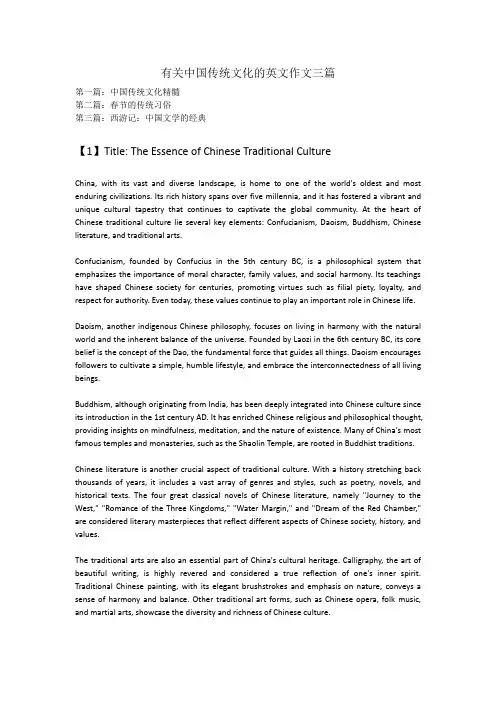
有关中国传统文化的英文作文三篇第一篇:中国传统文化精髓第二篇:春节的传统习俗第三篇:西游记:中国文学的经典【1】Title: The Essence of Chinese Traditional CultureChina, with its vast and diverse landscape, is home to one of the world's oldest and most enduring civilizations. Its rich history spans over five millennia, and it has fostered a vibrant and unique cultural tapestry that continues to captivate the global community. At the heart of Chinese traditional culture lie several key elements: Confucianism, Daoism, Buddhism, Chinese literature, and traditional arts.Confucianism, founded by Confucius in the 5th century BC, is a philosophical system that emphasizes the importance of moral character, family values, and social harmony. Its teachings have shaped Chinese society for centuries, promoting virtues such as filial piety, loyalty, and respect for authority. Even today, these values continue to play an important role in Chinese life.Daoism, another indigenous Chinese philosophy, focuses on living in harmony with the natural world and the inherent balance of the universe. Founded by Laozi in the 6th century BC, its core belief is the concept of the Dao, the fundamental force that guides all things. Daoism encourages followers to cultivate a simple, humble lifestyle, and embrace the interconnectedness of all living beings.Buddhism, although originating from India, has been deeply integrated into Chinese culture since its introduction in the 1st century AD. It has enriched Chinese religious and philosophical thought, providing insights on mindfulness, meditation, and the nature of existence. Many of China's most famous temples and monasteries, such as the Shaolin Temple, are rooted in Buddhist traditions.Chinese literature is another crucial aspect of traditional culture. With a history stretching back thousands of years, it includes a vast array of genres and styles, such as poetry, novels, and historical texts. The four great classical novels of Chinese literature, namely "Journey to the West," "Romance of the Three Kingdoms," "Water Margin," and "Dream of the Red Chamber," are considered literary masterpieces that reflect different aspects of Chinese society, history, and values.The traditional arts are also an essential part of China's cultural heritage. Calligraphy, the art of beautiful writing, is highly revered and considered a true reflection of one's inner spirit. Traditional Chinese painting, with its elegant brushstrokes and emphasis on nature, conveys a sense of harmony and balance. Other traditional art forms, such as Chinese opera, folk music, and martial arts, showcase the diversity and richness of Chinese culture.In conclusion, Chinese traditional culture is a multifaceted and enduring reflection of the nation's history, values, and beliefs. Its impact can be felt not only within China but also across the globe, as people from all walks of life are drawn to its unique charm and wisdom. As the world continues to evolve, Chinese traditional culture remains a source of inspiration and pride for the Chinese people and a testament to the resilience and creativity of human civilization.【2】Title: The Customs and Traditions of Chinese Spring FestivalThe Chinese Spring Festival, also known as Lunar New Year, is the most important and widely-celebrated holiday in China. It marks the beginning of the lunar calendar and is a time when families come together to welcome the new year with joy and prosperity. Rooted in centuries-old traditions, the Spring Festival embodies a rich tapestry of customs that have been passed down through generations. Here, we will delve into some of the most significant and fascinating practices associated with the festival.Preparations for the Spring Festival begin weeks in advance, with families cleaning their homes from top to bottom in a ritual known as "sweeping away the bad luck." This thorough cleaning is symbolic of driving away negative energy and making room for good fortune in the coming year. Homes are also adorned with red decorations, including lanterns, couplets, and paper cutouts, which represent happiness, prosperity, and good luck. Red, an auspicious color in Chinese culture, is believed to ward off evil spirits and bring good fortune.On the eve of the Spring Festival, families gather for a sumptuous reunion dinner, which is considered the most important meal of the year. The dinner table is laden with an array of dishes, each symbolizing a specific blessing for the new year. Fish, for example, represents abundance, while dumplings, with their-shaped like ancient gold ingots, symbolize wealth and prosperity. Family members indulge in these delicacies, sharing laughter and conversation as they usher in the new year together.One of the most well-known customs of the Spring Festival is the giving and receiving of red envelopes or "hongbao," which are filled with money. Traditionally, these envelopes are given by elders to younger family members as a symbol of their blessings and good wishes. The money inside the envelopes is believed to ward off evil spirits and bring good luck to the recipients in the coming year.Fireworks and firecrackers are also a prominent feature of the Spring Festival, as their loud explosions are believed to scare away evil spirits. Families and communities come together to light fireworks, filling the night sky with a dazzling spectacle of colors and sounds. This tradition has persisted for centuries, although some modern cities have introduced restrictions on fireworks to reduce air pollution and ensure safety.The Spring Festival celebrations culminate with the Lantern Festival, which falls on the fifteenthday of the first lunar month. During this time, streets and parks are illuminated with colorful lanterns, and people participate in riddle-solving games, enjoy traditional performances, and indulge in glutinous rice balls called "tangyuan," symbolizing family unity and togetherness.In conclusion, the customs and traditions of the Chinese Spring Festival reflect the richness and depth of Chinese culture. They embody the values of family, unity, and prosperity, while offering a fascinating glimpse into the beliefs and practices that have been passed down through generations. As the world becomes increasingly interconnected, the Spring Festival continues to captivate people of diverse cultures, who are drawn to its vibrant colors, tantalizing flavors, and profound symbolism.【3】Title: Journey to the West: A Classic of Chinese Literature"Journey to the West," also known as "Xiyouji" in Chinese, is one of the Four Great Classical Novels of Chinese literature. Written during the Ming Dynasty by Wu Cheng'en, the novel is a captivating blend of myth, legend, and adventure that has captured the hearts and imaginations of readers for centuries. This literary masterpiece not only provides a fascinating glimpse into Chinese history, culture, and beliefs, but also serves as a powerful allegory for spiritual growth and self-improvement.The story of "Journey to the West" is centered on the legendary pilgrimage of a Buddhist monk named Xuanzang, who travels from China to India in search of sacred Buddhist scriptures. Accompanying him on his perilous journey are four supernatural beings: Sun Wukong, the mischievous and resourceful Monkey King; Zhu Bajie, a pig-human hybrid with insatiable appetites for food and lust; Sha Wujing, a diligent and dependable river monster; and a white dragon horse that serves as Xuanzang's steed.Throughout the journey, Xuanzang and his companions encounter a myriad of challenges, including powerful demons, treacherous landscapes, and moral dilemmas. Each challenge serves as a test of their character, wisdom, and faith, ultimately shaping them into more virtuous and enlightened beings. While the narrative is filled with action, humor, and suspense, it also carries a deeper message about the importance of perseverance, compassion, and the transformative power of spiritual growth."Journey to the West" is notable for its rich and vivid portrayal of Chinese culture and mythology. The novel is steeped in Chinese folktales, legends, and Buddhist teachings, offering a unique window into the beliefs and values of ancient China. The characters in the story embody various aspects of human nature, such as courage, loyalty, cunning, and desire, providing valuable insights into the human condition.Furthermore, the novel has had a lasting impact on both Chinese and world literature. The character of Sun Wukong, the Monkey King, has become a symbol of rebellion, resourcefulness, and intelligence in Chinese culture. He has inspired countless adaptations, reinterpretations, andspin-offs, including the popular Japanese manga and anime series "Dragon Ball," which draws heavily from the character and themes of "Journey to the West."In conclusion, "Journey to the West" is a timeless classic of Chinese literature that continues to captivate and inspire readers from all walks of life. Its rich narrative, unforgettable characters, and profound messages about spiritual growth, resilience, and the human condition have solidified its status as a literary masterpiece. As the world becomes increasingly interconnected, the enduring appeal of "Journey to the West" is a testament to the power of stories to transcend cultural boundaries and unite people through the shared experience of imagination and wonder.。
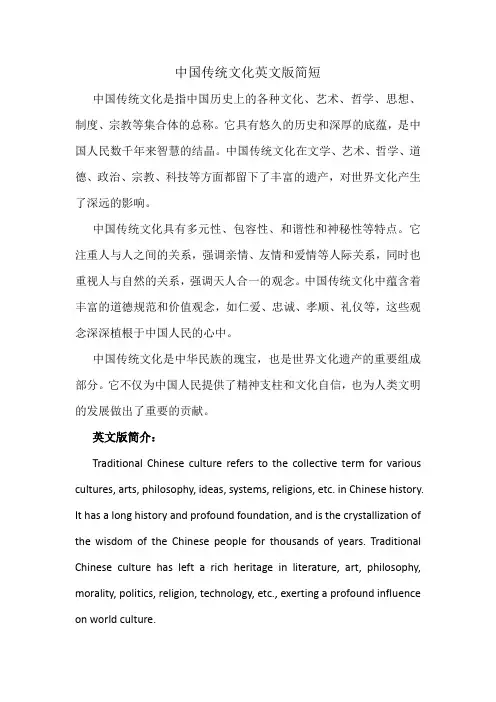
中国传统文化英文版简短中国传统文化是指中国历史上的各种文化、艺术、哲学、思想、制度、宗教等集合体的总称。
它具有悠久的历史和深厚的底蕴,是中国人民数千年来智慧的结晶。
中国传统文化在文学、艺术、哲学、道德、政治、宗教、科技等方面都留下了丰富的遗产,对世界文化产生了深远的影响。
中国传统文化具有多元性、包容性、和谐性和神秘性等特点。
它注重人与人之间的关系,强调亲情、友情和爱情等人际关系,同时也重视人与自然的关系,强调天人合一的观念。
中国传统文化中蕴含着丰富的道德规范和价值观念,如仁爱、忠诚、孝顺、礼仪等,这些观念深深植根于中国人民的心中。
中国传统文化是中华民族的瑰宝,也是世界文化遗产的重要组成部分。
它不仅为中国人民提供了精神支柱和文化自信,也为人类文明的发展做出了重要的贡献。
英文版简介:Traditional Chinese culture refers to the collective term for various cultures, arts, philosophy, ideas, systems, religions, etc. in Chinese history. It has a long history and profound foundation, and is the crystallization of the wisdom of the Chinese people for thousands of years. Traditional Chinese culture has left a rich heritage in literature, art, philosophy, morality, politics, religion, technology, etc., exerting a profound influence on world culture.Traditional Chinese culture has the characteristics of diversity, inclusivity, harmony, and mystery. It emphasizes the relationship between people, emphasizing interpersonal relationships such as family ties, friendship, and love, while also emphasizing the relationship between man and nature, emphasizing the concept of harmony between heaven and earth. Traditional Chinese culture contains a rich vocabulary of moral norms and values such as benevolence, loyalty, filial piety, and etiquette, which are deeply ingrained in the hearts of the Chinese people.Traditional Chinese culture is a national treasure of the Chinese nation and an important part of world cultural heritage. It not only provides a spiritual pillar and cultural confidence for the Chinese people, but also makes an important contribution to the development of human civilization.。
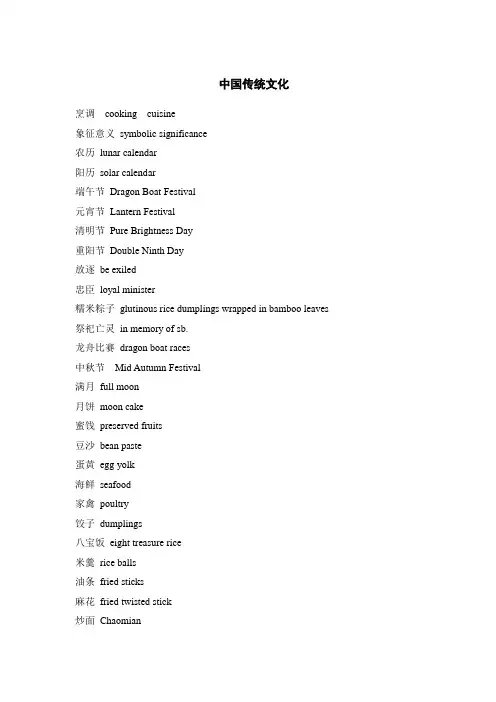
中国传统文化烹调cooking cuisine象征意义symbolic significance农历lunar calendar阳历solar calendar端午节Dragon Boat Festival元宵节Lantern Festival清明节Pure Brightness Day重阳节Double Ninth Day放逐be exiled忠臣loyal minister糯米粽子glutinous rice dumplings wrapped in bamboo leaves 祭祀亡灵in memory of sb.龙舟比赛dragon boat races中秋节Mid Autumn Festival满月full moon月饼moon cake蜜饯preserved fruits豆沙bean paste蛋黄egg yolk海鲜seafood家禽poultry饺子dumplings八宝饭eight treasure rice米羹rice balls油条fried sticks麻花fried twisted stick炒面Chaomian叉烧包steamed bun with roast pork粥porridge芋头taro葱油饼pan-fried cake with sesame seeds and green onion有关春节的常用词放鞭炮let off firecrackers耍龙灯play the dragon lantern耍狮子play the lion dance拜年pay a new-year call中国古代独特事物(Unique Ancient Chinese Items)宣纸rice paper衙门yamen叩头kowtow孔子Confucius武术 wushu(Chinese Martial Arts)功夫kungfu ;kung fu中庸the way of medium (cf. Golden Means)中和harmony (zhonghe)孝顺to show filial obedience孝子dutiful son家长family head三纲:君为臣纲,父为子纲,夫为妻纲three cardinal guides: ruler guides subject, father guides son husband guides wife五常:仁、义、理、智、信five constant virtues: benevolence (humanity), righteousness, propriety, wisdom and fidelity八股文eight-legged essays多子多福:The more sons/children, the more blessing/ great happiness养儿防老:raising sons to support one in one’s old age1.元宵节:Lantern Festival2.刺绣:embroidery3.重阳节:Double-Ninth Festival4.清明节:Tomb sweeping day5.剪纸:Paper Cutting6.书法:Calligraphy7.对联:(Spring Festival) Couplets8.象形文字:Pictograms/Pictographic Characters9.人才流动:Brain Drain/Brain Flow10.四合院:Siheyuan/Quadrangle11.战国:Warring States12.风水:Fengshui/Geomantic Omen13.铁饭碗:Iron Bowl14.函授部:The Correspondence Department15.集体舞:Group Dance16.黄土高原:Loess Plateau17.红白喜事:Weddings and Funerals18.中秋节:Mid-Autumn Day19.结婚证:Marriage Certificate20.儒家文化:Confucian Culture21.附属学校:Affiliated school22.古装片:Costume Drama23.武打片:Chinese Swordplay Movie24.元宵:Tangyuan/Sweet Rice Dumpling (Soup)25.一国两制:One Country, Two Systems26.火锅:Hot Pot27.四人帮:Gang of Four28.《诗经》:The Book of Songs29.素质教育:Essential-qualities-oriented Education30.《史记》:Historical Records/Records of the Grand Historian31.大跃进:Great Leap Forward (Movement)32.《西游记》:The Journey to the West33.除夕:Chinese New Year’s Eve/Eve of the Spring Festival34.针灸:Acupuncture35.唐三彩:Tri-color Pottery of the Tang Dynasty/ The Tang Tri-colored pottery36.中国特色的社会主义:Chinese-charactered Socialist/Socialist with Chinese characteristics37.偏旁:radical38.孟子:Mencius39.亭/阁:Pavilion/ Attic40.大中型国有企业:Large and Medium-sized State-owned Enterprises41.火药:gunpowder42.农历:Lunar Calendar43. 印/玺:Seal/Stamp44. 物质精神文明建设:The Construction of Material Civilization and Spiritual Civilization45.京剧:Beijing Opera/Peking Opera46.秦腔:Crying of Qin People/Qin Opera47.太极拳:Tai Chi实考题分析中国的传统节庆膳食除了在数量和质量上与平时有所不同之外,一些历史悠久、具有象征意义的食物也是节日必不可缺的伴侣。
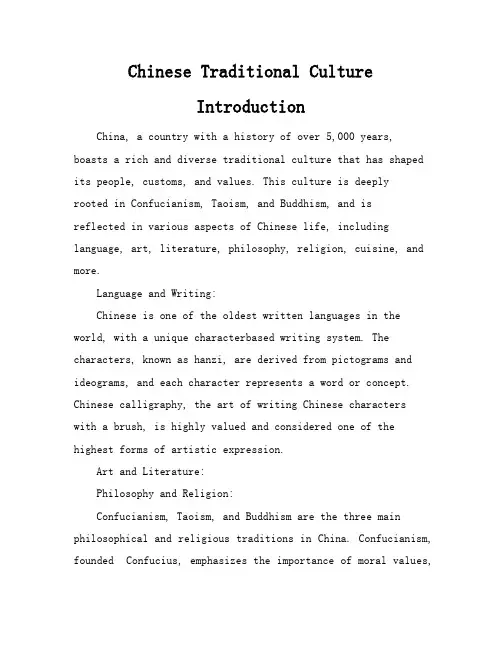
Chinese Traditional CultureIntroductionChina, a country with a history of over 5,000 years, boasts a rich and diverse traditional culture that has shaped its people, customs, and values. This culture is deeplyrooted in Confucianism, Taoism, and Buddhism, and isreflected in various aspects of Chinese life, including language, art, literature, philosophy, religion, cuisine, and more.Language and Writing:Chinese is one of the oldest written languages in the world, with a unique characterbased writing system. The characters, known as hanzi, are derived from pictograms and ideograms, and each character represents a word or concept. Chinese calligraphy, the art of writing Chinese characterswith a brush, is highly valued and considered one of the highest forms of artistic expression.Art and Literature:Philosophy and Religion:Confucianism, Taoism, and Buddhism are the three main philosophical and religious traditions in China. Confucianism, founded Confucius, emphasizes the importance of moral values,social harmony, and filial piety. Taoism, founded Laozi, emphasizes the pursuit of harmony with nature and the Tao, or the Way. Buddhism, which originated in India, focuses on the Four Noble Truths and the Eightfold Path as a means to achieve enlightenment and escape suffering.Cuisine:Chinese cuisine is one of the most diverse and flavorful in the world, with a wide variety of regional styles and dishes. Some of the most famous Chinese dishes include Peking duck, dim sum, hot pot, and dumplings. Chinese cooking techniques are also diverse, including stirfrying, steaming, boiling, and roasting.Festivals and Celebrations:China has a rich tradition of festivals and celebrations, many of which are based on the lunar calendar. Some of the most important festivals include the Spring Festival (Chinese New Year), the MidAutumn Festival, the Dragon Boat Festival, and the Lantern Festival. These festivals are celebrated with traditional customs, such as lighting lanterns, eating special foods, and watching fireworks.Traditional Medicine:Traditional Chinese medicine (TCM) is a holistic system of medicine that has been practiced for thousands of years. TCM emphasizes the balance of yin and yang, and the use ofherbal remedies, acupuncture, and other treatments to promote health and wellbeing.Conclusion:Chinese traditional culture is a treasure trove of knowledge, wisdom, and beauty. It continues to influence the lives of people in China and around the world, and is a valuable resource for understanding the history and development of human civilization.ContinuedArchitecture and Gardens:Chinese architecture is renowned for its intricate designs, use of wood, and emphasis on harmony with nature. Traditional Chinese buildings often feature curved roofs, red columns, and decorative elements such as dragons and phoenixes. Chinese gardens, known for their balance of water, rocks, plants, and architecture, are designed to create a serene and contemplative atmosphere.Music and Dance:Chinese music has a long history, with various instruments such as the guqin (a sevenstringed zither), erhu (a twostringed fiddle), and pipa (a fourstringed lute). Traditional Chinese dance is also diverse, ranging from优雅的宫廷舞到欢快的民间舞,每一种舞蹈都有其独特的风格和意义。
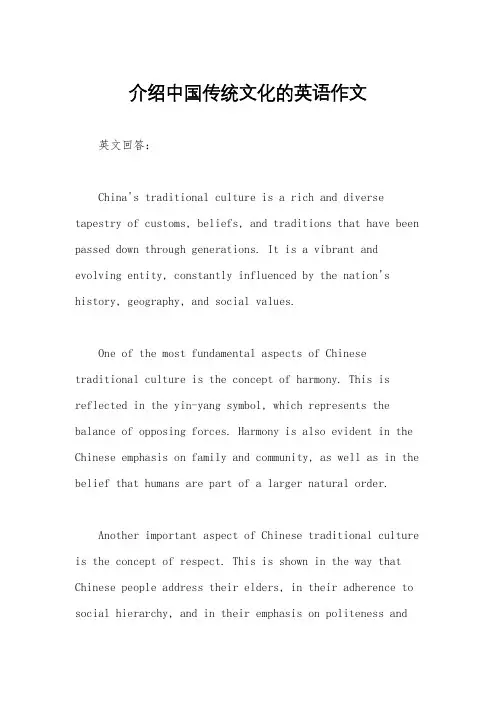
介绍中国传统文化的英语作文英文回答:China's traditional culture is a rich and diverse tapestry of customs, beliefs, and traditions that have been passed down through generations. It is a vibrant and evolving entity, constantly influenced by the nation's history, geography, and social values.One of the most fundamental aspects of Chinese traditional culture is the concept of harmony. This is reflected in the yin-yang symbol, which represents the balance of opposing forces. Harmony is also evident in the Chinese emphasis on family and community, as well as in the belief that humans are part of a larger natural order.Another important aspect of Chinese traditional culture is the concept of respect. This is shown in the way that Chinese people address their elders, in their adherence to social hierarchy, and in their emphasis on politeness andgood manners. Respect is also extended to the environment, as the Chinese believe that humans are responsible for preserving the natural world.Chinese traditional culture is also known for its emphasis on tradition and ritual. This is evident in the way that Chinese people celebrate holidays, such as the Spring Festival and the Mid-Autumn Festival. It is also seen in the way that Chinese people observe customs such as ancestor worship and filial piety.Finally, Chinese traditional culture is renowned forits artistic achievements. This includes the development of calligraphy, painting, music, and dance. Chinese art is often characterized by its beauty, elegance, and symbolism.中文回答:中国传统文化博大精深,源远流长,是中华民族在漫长的历史进程中创造和积累的宝贵遗产。
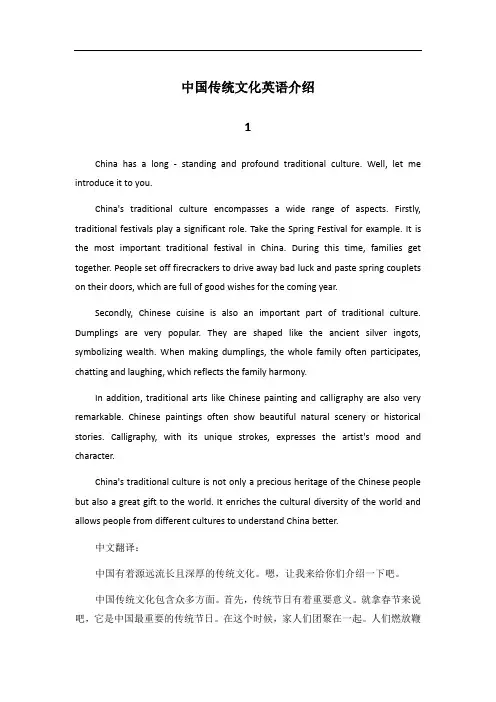
中国传统文化英语介绍1China has a long -standing and profound traditional culture. Well, let me introduce it to you.China's traditional culture encompasses a wide range of aspects. Firstly, traditional festivals play a significant role. Take the Spring Festival for example. It is the most important traditional festival in China. During this time, families get together. People set off firecrackers to drive away bad luck and paste spring couplets on their doors, which are full of good wishes for the coming year.Secondly, Chinese cuisine is also an important part of traditional culture. Dumplings are very popular. They are shaped like the ancient silver ingots, symbolizing wealth. When making dumplings, the whole family often participates, chatting and laughing, which reflects the family harmony.In addition, traditional arts like Chinese painting and calligraphy are also very remarkable. Chinese paintings often show beautiful natural scenery or historical stories. Calligraphy, with its unique strokes, expresses the artist's mood and character.China's traditional culture is not only a precious heritage of the Chinese people but also a great gift to the world. It enriches the cultural diversity of the world and allows people from different cultures to understand China better.中文翻译:中国有着源远流长且深厚的传统文化。
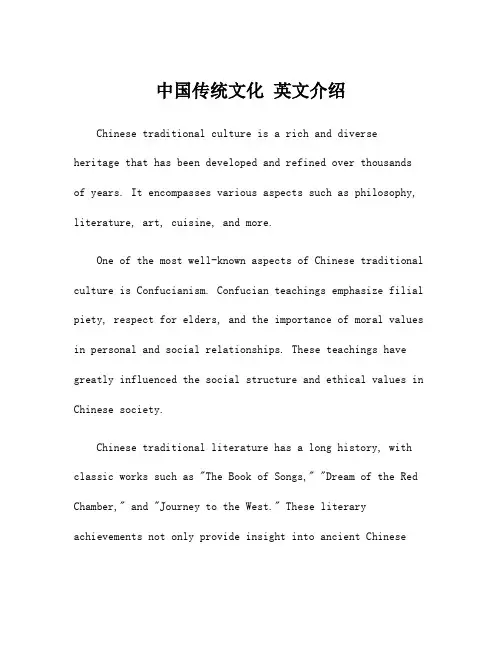
中国传统文化英文介绍Chinese traditional culture is a rich and diverse heritage that has been developed and refined over thousands of years. It encompasses various aspects such as philosophy, literature, art, cuisine, and more.One of the most well-known aspects of Chinese traditional culture is Confucianism. Confucian teachings emphasize filial piety, respect for elders, and the importance of moral values in personal and social relationships. These teachings have greatly influenced the social structure and ethical values in Chinese society.Chinese traditional literature has a long history, with classic works such as "The Book of Songs," "Dream of the Red Chamber," and "Journey to the West." These literary achievements not only provide insight into ancient Chinesesociety but also reflect the values, aspirations, and wisdom of the Chinese people.Chinese traditional art covers various forms, including calligraphy, painting, sculpture, and traditional Chinese opera. Chinese calligraphy is regarded as a visual expression of one's inner thoughts and emotions, with its graceful strokes and intricate characters. Traditional Chinesepainting often features the natural beauty of landscapes, using a brush and ink to create a sense of serenity and harmony.Chinese traditional cuisine is known for its diverse flavors and cooking techniques. It places great emphasis on the balance of taste, texture, and color. Key ingredients such as rice, noodles, soybeans, and various spices are used to create a wide range of dishes, each with their unique regional characteristics.Another important aspect of Chinese traditional culture is festivals. Festivals such as the Spring Festival (Chinese New Year), Mid-Autumn Festival, and Dragon Boat Festival are celebrated with various traditional customs and activities. These festivals not only bring families together but also showcase the rich cultural heritage of China.Overall, Chinese traditional culture is a treasure trove of wisdom, aesthetics, and traditions that have been passed down through generations. It continues to shape the lives and values of the Chinese people, contributing to the unique identity and splendor of Chinese civilization.。
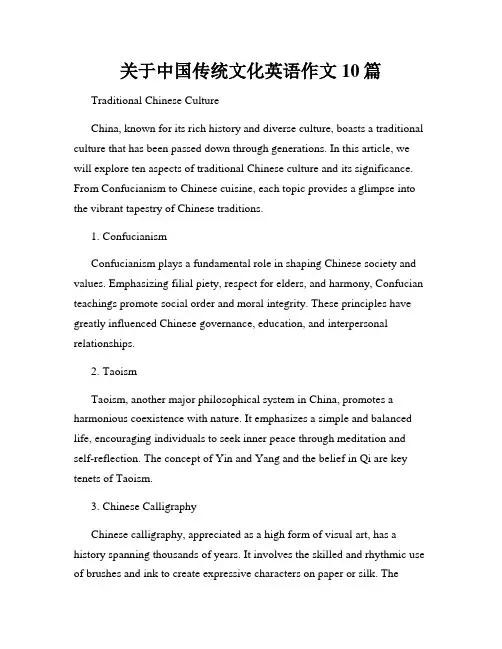
关于中国传统文化英语作文10篇Traditional Chinese CultureChina, known for its rich history and diverse culture, boasts a traditional culture that has been passed down through generations. In this article, we will explore ten aspects of traditional Chinese culture and its significance. From Confucianism to Chinese cuisine, each topic provides a glimpse into the vibrant tapestry of Chinese traditions.1. ConfucianismConfucianism plays a fundamental role in shaping Chinese society and values. Emphasizing filial piety, respect for elders, and harmony, Confucian teachings promote social order and moral integrity. These principles have greatly influenced Chinese governance, education, and interpersonal relationships.2. TaoismTaoism, another major philosophical system in China, promotes a harmonious coexistence with nature. It emphasizes a simple and balanced life, encouraging individuals to seek inner peace through meditation and self-reflection. The concept of Yin and Yang and the belief in Qi are key tenets of Taoism.3. Chinese CalligraphyChinese calligraphy, appreciated as a high form of visual art, has a history spanning thousands of years. It involves the skilled and rhythmic use of brushes and ink to create expressive characters on paper or silk. Thestrokes and structure of each character convey the artist's emotions and aesthetics.4. Traditional FestivalsChina's traditional festivals are an essential part of its cultural identity. Events like the Spring Festival (Chinese New Year), Dragon Boat Festival, and Mid-Autumn Festival not only celebrate the changing seasons but also provide opportunities for family reunions and cultural exchange. Festivals often include vibrant displays of dragon dances, lanterns, and traditional performances.5. Chinese OperaChinese opera, with its distinct music, singing, and intricate costumes, is a combination of theater, music, and dance. It has a history of over 1,000 years and encompasses different regional styles, such as Peking Opera, Yue Opera, and Kunqu Opera. Chinese opera showcases traditional stories, myths, and historical events, and requires highly skilled performers.6. Martial ArtsMartial arts, known as "Wushu" in Chinese, embodies both physical exercise and philosophical principles. Styles such as Tai Chi and Kung Fu emphasize discipline, concentration, and balance. Practitioners not only develop self-defense skills but also cultivate mental and spiritual strength.7. Traditional Chinese MedicineTraditional Chinese Medicine (TCM) is a holistic and ancient approach to healthcare that encompasses various practices. Acupuncture, herbalmedicine, and Qi Gong are integral parts of TCM. TCM focuses on balancing Yin and Yang, promoting the body's self-healing mechanisms, and maintaining overall well-being.8. Tea CultureTea plays a significant role in Chinese culture, symbolizing hospitality, respect, and tranquility. The art of tea preparation and appreciation dates back thousands of years. Chinese tea ceremonies emphasize mindfulness, simplicity, and the enjoyment of the tea's aroma, color, and taste.9. Feng ShuiFeng Shui, an ancient Chinese practice, aims to create harmonious environments by balancing energy flows. It considers factors such as the placement of furniture, colors, and natural elements to optimize the flow of positive energy. Feng Shui is widely believed to bring good luck, enhance health, and promote prosperity.10. Chinese CuisineChinese cuisine is renowned for its diversity, flavors, and cooking techniques. From fiery Sichuan cuisine to delicate Cantonese dim sum, each regional cuisine represents distinctive flavors, ingredients, and cooking methods. The importance of food in Chinese culture is evident through the practice of family-style dining and the symbolism associated with certain dishes.In conclusion, traditional Chinese culture encompasses a range of practices and beliefs that have shaped Chinese society for centuries. From philosophy to the arts, these aspects reflect Chinese values, customs, and adeep-rooted connection to history. Exploring traditional Chinese culture reveals a wealth of traditions and wisdom that continue to influence and inspire people both within and beyond China.。
中国传统文化的英语介绍:Traditional Chinese culture encompasses a rich and diverse heritage that has evolved over thousands of years. It is deeply rooted in the philosophical, artistic, and social traditions of ancient China. This culture has made significant contributions to various fields, including literature, philosophy, art, music, medicine, and martial arts, among others.Confucianism, Taoism, and Buddhism are the three major philosophical and spiritual traditions that have greatly influenced Chinese society. Confucianism emphasizes moral values, social harmony, and the cultivation of virtues, while Taoism focuses on living in harmony with the natural order. Buddhism, originating from India, has also played a key role in shaping Chinese culture, particularly in terms of its impact on art, architecture, and concepts of enlightenment.Chinese calligraphy, one of the highest forms of artistic expression, combines aesthetics, technique, and cultural symbolism. It is regarded as both a visual art and a means of spiritual cultivation. Traditional Chinese painting, characterized by its use ofbrushstrokes and ink, often portrays landscapes, nature, and figures. It aims to convey not only the physical appearance but also the inner spirit and essence of the subject.Chinese cuisine is renowned worldwide for its diversity, flavors, and techniques. It encompasses various regional styles such as Cantonese, Sichuan, and Shandong cuisine, each with its distinctive ingredients and cooking methods. The principles of balance, harmony, and holistic nutrition are integral to Chinese culinary traditions.In addition, traditional Chinese festivals hold great cultural significance. The Spring Festival (Chinese New Year), Dragon Boat Festival, Mid-Autumn Festival, and Lantern Festival are among the most widely celebrated events, featuring colorful customs, rituals, and traditional performances.Traditional Chinese culture continues to thrive in modern society, with efforts to preserve and promote its rich heritage. It serves as a source of inspiration, guiding principles, and a reflection of the profound wisdom accumulated by generations of Chinese people.。
关于中国传统文化的手抄报英文版Chinese Traditional CultureIntroduction:Chinese traditional culture is one of the richest and oldest cultures in the world. It is deeply rooted and has evolved over thousands of years, influencing various aspects of Chinese society. In this English version of a handwritten report, we will explore key elements of Chinese traditional culture and their significance.Confucianism:Confucianism is a philosophical and ethical system developed by Confucius, a great Chinese scholar and philosopher. It emphasizes the importance of morality, family values, respect for elders, and social harmony. Confucian teachings have had a profound impact on Chinese society, shaping its social structure, education, and governance.Filial Piety:Filial piety, also known as "xiao," is a fundamental principle in Chinese traditional culture. It refers to the respect, obedience, and care children should have towards their parents and elders. Filial piety is regarded as a virtue that maintains family harmony and social order. It is reflected in the Chinese saying, "Respecting parents is a universal virtue."Chinese Calligraphy:Chinese calligraphy is not only a form of writing but also an art that combines aesthetics, culture, and human expression. It has a long history andis considered one of the highest forms of visual art in China. Calligraphy requires precise brushstrokes, rhythm, and an understanding of Chinese characters to convey meaning. It embodies the beauty of written language.Traditional Festivals:Chinese traditional festivals provide a glimpse into the rich cultural heritage of China. The Chinese New Year, also known as Spring Festival, is the most important festivity of the year. It is celebrated with family gatherings, fireworks, red envelopes, and traditional lion dances. Other major festivals include the Lantern Festival, Dragon Boat Festival, and Mid-Autumn Festival, each with unique customs and traditions.Traditional Chinese Medicine:Traditional Chinese Medicine (TCM) is a holistic approach to health and well-being. It is based on the principles of balancing Yin and Yang and the flow of Qi (life force) in the body. TCM includes various practices such as acupuncture, herbal medicine, massage (Tui Na), and dietary therapy. It has been widely used for thousands of years and continues to be an integral part of Chinese culture.Chinese Opera:Chinese opera is a traditional form of performing arts that combines music, singing, dance, martial arts, and elaborate costumes. It originated in the Tang Dynasty and has evolved into several regional styles, including Beijing Opera, Cantonese Opera, and Sichuan Opera. Chinese opera tells stories from ancient history, mythology, and folklore, preserving cultural heritage through dramatic performances.Traditional Cuisine:Chinese cuisine is renowned for its diversity, flavors, and nutritional balance. Each region in China has its own culinary specialties, such as Sichuan cuisine, Cantonese cuisine, and Shanghainese cuisine. Traditional techniques like stir-frying, steaming, braising, and using a wide variety of ingredients, including rice, noodles, tofu, and various meats, contribute to the uniqueness of Chinese cuisine.Conclusion:Chinese traditional culture embodies the wisdom, values, and aesthetics of the Chinese people. It has stood the test of time and continues to shape Chinese society today. From Confucianism and filial piety to Chinese calligraphy, traditional festivals, medicine, opera, and cuisine, these cultural elements reflect the richness and diversity of Chinese heritage. By appreciating and preserving these traditions, we can better understand and respect the essence of Chinese traditional culture.。
中国传统文化英文简介China has a long history and a rich traditional culture. Chinese traditional culture covers various aspects, including philosophy, literature, art, medicine, and more. Here is a brief introduction to some key aspects of Chinese traditional culture:Philosophy: The core of Chinese traditional culture is Confucianism, Taoism, and Buddhism. Confucianism emphasizes personal cultivation, social ethics, and hierarchy, while Taoism emphasizes the harmony between nature and humanity, and Buddhism emphasizes spiritual practice and enlightenment.Literature: Chinese literature has a long history, including poetry, prose, drama, and novels. Some of the most famous works include "The Dream of the Red Chamber," "Journey to the West," and "The Three Kingdoms."Art: Chinese art includes calligraphy, painting, sculpture, and more. Calligraphy and painting are especially renowned for their unique styles and techniques, and traditional Chinese painting emphasizes the expression of nature and the spiritual realm.Medicine: Traditional Chinese medicine (TCM) is an important part of Chinese culture. It emphasizes the balance of Yin and Yang and the use of herbal medicine and acupuncture to treat diseases.Customs: Chinese customs include many traditional festivals, such as the Spring Festival, the Mid-Autumn Festival, and the Dragon Boat Festival. These festivals often involve family gatherings, special foods, and cultural activities.In summary, Chinese traditional culture is a diverse and profound system that encompasses philosophy, literature, art, medicine, and more. It has had a profound impact on Chinese society and continues to play an important role in modern life.。
中国传统文化英文展示如下:Chinese traditional culture is a broad concept that encompasses the various cultural practices, beliefs, and customs that have been passed down from generation to generation in China. It has a history of over 5,000 years and is deeply rooted in Confucianism, Taoism, and Buddhism.One of the most prominent aspects of Chinese traditional culture is the importance placed on family values and filial piety. Respect for elders and maintaining harmonious relationships within the family are highly valued. This is reflected in many aspects of daily life, such as the emphasis on ancestor worship and the celebration of festivals like the Lunar New Year and Mid-Autumn Festival, which are times for families to come together.Another important aspect of Chinese traditional culture is the arts. Calligraphy, painting, music, dance, and opera have all been integral parts of Chinese culture for centuries. These art forms often carry deep philosophical and moral meanings and are seen as expressions of the human spirit.Traditional Chinese medicine, which includes practices such as acupuncture, herbal medicine, and tai chi, is also a significant part of Chinese culture. It emphasizes the importance of balance and harmony in the body and the natural world.Furthermore, Chinese cuisine, with its wide variety of flavors and cooking techniques, is another essential aspect of traditional culture. Food plays a central role in social gatherings and is often used as a way to express hospitality and respect.Overall, Chinese traditional culture is a rich tapestry of history, philosophy, art, and customs that continue to influence modern Chinese society and beyond.。
高中英语高考英语作文有关中国传统文化的范文5篇带中文翻译范文一:中国传统节日Chinese traditional festivals play an important role in Chinese culture. Among them, the Spring Festival is the most significant one. It is a time for family reunion, when people gather together, have festive meals, and exchange blessings. The Dragon Boat Festival and Mid-Autumn Festival are also celebrated widely. These festivals not only offer people a chance to relax and enjoy themselves, but also promote traditional values and customs, such as filial piety and respect for ancestors. Through these festivals, we can learn more about Chinese history, traditions, and customs, and pass them on to future generations.范文二:中国传统艺术Chinese traditional art, with a history of thousands of years, is a treasure of Chinese culture. Calligraphy, for example, is considered as the essence of Chinese culture. It not only requires skillful brushwork, but also embodies the beauty of Chinese characters. Chinese paintings, known for their unique painting techniques and rich cultural connotations, are admired by people all over the world. In addition, traditional Chinese music, opera, and dance are also highly appreciated for their elegance and grace. These art forms not only reflect the aesthetics of Chinese people, but also convey profound cultural meanings.范文三:中国传统美食Chinese traditional cuisine is renowned worldwide for its diversity and flavors. From the spicy Sichuan cuisine to the delicate Cantonese cuisine, each region has its own specialty dishes. For example, Peking duck, known for its crispy skin and tender meat, is a must-try when visiting Beijing. Dim sum, a variety of bite-sized dishes, is a popular choice for breakfast or afternoon tea in southern China. Chinese cuisine not only satisfies people's taste buds, but also reflects the philosophy of balance and harmony in Chinese culture. The art of Chinese cooking has been passed down from generation to generation, and it continues to evolve and innovate while preserving its traditional roots.范文四:中国传统服饰Traditional Chinese clothing, known as Hanfu, has a long history and unique charm. It is characterized by its loose, flowing silhouette and exquisite craftsmanship. Hanfu consists of various garments, such as the Ruqun for women and the Zhongshan suit for men. Each garment has its own distinctive style and symbolic meaning. Traditional Chinese clothing not only reflects the aesthetic taste of different dynasties, but also represents the etiquette and social status of the wearers. Nowadays, Hanfu is experiencing a revival, and more and more people are embracing it as a way to showcase their cultural identity and appreciation for Chinese traditions.范文五:中国传统建筑Chinese traditional architecture, with its distinctive style and profound cultural connotations, is a true representation of Chinese culture. The Forbidden City in Beijing, with its grandeur and meticulous design, is a masterpiece of traditional Chinese architecture. The classical gardens in Suzhou, known for their harmonious layout and exquisite details, showcase the perfect integration of nature and human creations. Traditional Chinese architecture also emphasizes the balance of Yin and Yang, and the harmony between man and nature. It is not only a manifestation of architectural skills, but also a reflection of the wisdom and philosophy of the Chinese people.范文一:中国传统节日中国传统节日在中国文化中占有重要地位。